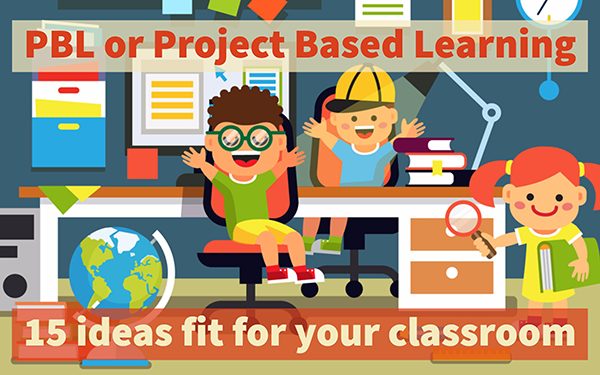
Lucie Renard —
PBL, a term you’ve probably seen a few times as a teacher. But what does it actually mean? And how do you use it in your classroom? PBL, or project-based learning. That’s what this post is about.

Project-based learning - Definition
PBL or project-based learning is a learning method in which students identify a real-world problem and develop its solution. Students gain knowledge and skills by working for a longer period of time to investigate and respond to an engaging or complex question, problem or challenge.
Guide your students to identify, through research, a real-world problem of which they have to develop a solution using evidence to support the claim. They have to present their project through a multimedia approach based on a set of 21st-century tools.
Students show what they learn as they go through the unit, interact with the lessons, collaborate with each other and assess themselves and each other.

Why should you use project-based learning?
Project-based learning is not something new, teachers just didn’t use it a lot when you were young. The ordinary way of teaching is teaching with disconnected lessons. Daily lessons that teach a skill which fits into a unit based on a topic or a theme. But, each lesson works independently and doesn’t connect other units in a learning story.
Besides creating a learning story that connects everything to each other, there are plenty other reasons to use PBL:
1. PBL provides opportunities for students to use technology

Most students are using technology and apps almost
every day. They are familiar with and enjoy using a variety of tech tools. As it happens, tech tools can be a perfect fit with project-based learning. With those tools and apps, teachers and students can find the right resources, information, create products and collaborate more effectively. They can even reach out to communities, experts and partners.
2. PBL promotes lifelong learning

Because technology is present, its use enables students, teachers and administrators to reach out beyond the school building. PBL also teaches students to take control of their learning, the first step as a lifelong learner.
3. PBL connect students and schools with the real world

Project-based learning enables students to solve problems and address issues important to them, their communities, and the world. Through PBL, students learn how to interact with adults and organizations. They are exposed to real workplaces and jobs so they will develop career interests. Even parents and other partners can be involved in certain projects.
4. PBL lends itself to formative and authentic assessment

allows us to systematically document a student’s progress and development. Authentic assessment focuses on deep learning, asking thorough questions.
Why is this any different than any other class? Well, PBL encourages formative and authentic assessment by doing the following:
- It allows students to demonstrate their capabilities while working independently.
- It lets teachers have multiple assessment opportunities.
- It shows the student’s ability to apply skills such as doing research.
- It develops a student’s ability to work with other students, building teamwork and group skills.
- The teacher learns more about the student as a person.
- It helps the teachers communicate in meaningful ways with the student or a team. Being able to give meaningful feedback is very important.
5. PBL encourages students to be more engaged and to learn actively

The fact that students are working on a project that has to be the key of solving a problem, makes them more actively involved. A real project engages their mind and their hearts. It’s a real world relevance for learning.
6. PBL builds skills for college, career and life

Success in life requires more than knowledge and skills. With PBL, students learn how to take initiative, be responsible and build a good attitude. They learn to build their confidence, solve problems, work in teams, and communicate ideas.
7. PBL encourages imagination and creativity

When you need to solve a problem, you have to be inventive and creative. PBL often asks to solve world class problems, so thinking out of the box is necessary. Because there are no real guidelines, visual design, drawing, and creating are very important elements within project based learning.

15 project-based learning ideas for in your classroom
Project-based learning has no magic plan you can use to guide you. It’s flexible and it’s a curriculum planning tool that’s often used to “embed” other learning methods like game-based learning, blended learning, place-based learning, and so on.
This means you will need some inspiration to get a first taste of project-based learning. I went through some sites to find some challenging project-based learning examples. Here we go!
- Plant and manage a garden to feed local homeless
- Design an alert system to halt the spread of a deadly disease
- Artfully illustrate the global history of civil rights
- Film a documentary on a social issue few people see
- Redesign the complete school, including new content areas, grading, collaboration and community involvement
- Redesign public transport in your city
- Create an interactive family tree with voice-overs from family members.
- How to survive on a deserted island? What do you do?
- Develop a brand new invention
- Plan a school party
- Work out a modern school library system that encourages students to read
- Create and manage a YouTube channel for a self-determined and authentic purpose
- Design a book with educative physical exercises to keep students moving during the day
- Help local businesses increase environmental sustainability
- Solve your parent’s problem of being too busy.
These are just project-based learning ideas. You’ll have to work them out and include several other learning aspects and materials. Take a look at this example: Island survival. If you scroll down on that website, you’ll find a whole collection of project-based learning lessons, completely worked out for you.
Don’t know how to really start with project based learning? Here are some tips.
Wrap up
Now that you know the meaning of PBL and gathered inspiration, it is time to apply it in your classroom. Let us know on Twitter how it went! Also, don’t forget to take a look at our Facebook Group. It will keep you informed of new blog posts.
And me? My name is Lucie. Connect with me on LinkedIn!

















0 archived comments